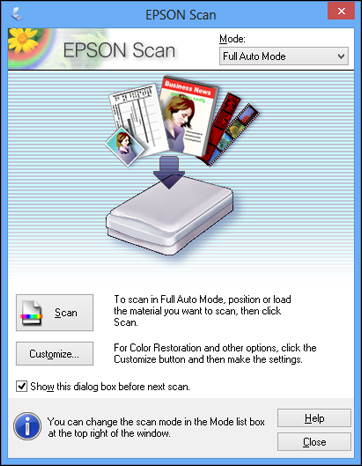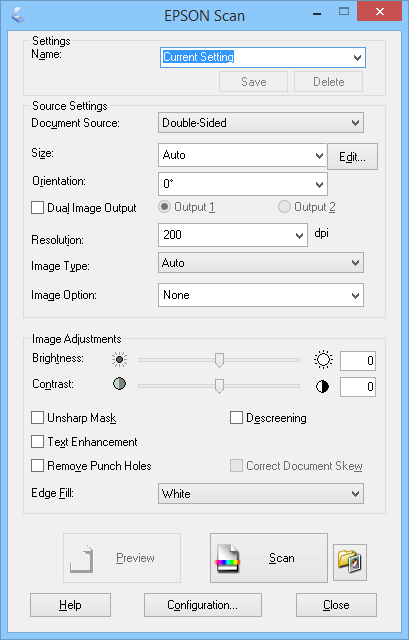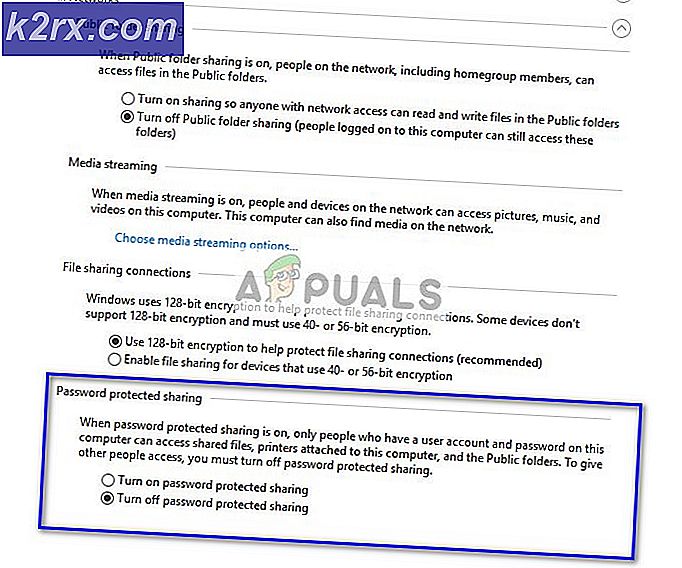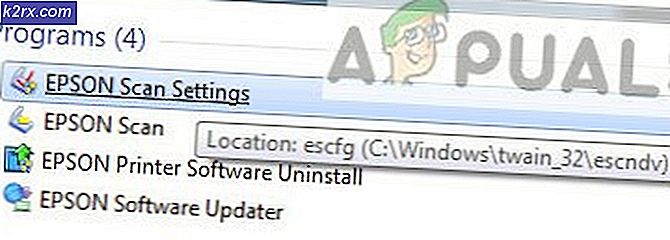About Press Copyright Contact us Creators Advertise Developers Terms Privacy Policy & Safety How YouTube works Test new features Press Copyright Contact us Creators. Overview of the Epson Scan Modes. Epson Scan lets you control all aspects of scanning. The EPSON Scan software is the same on Macintosh and Windows, so these instructions work for both platforms. Note: If you want to scan a document or image(s), see How to Scan Documents and Images with EPSON Scan or How to Scan Using the Fujitsu Scanners. Before you get started. We recommend you use a film holder, which helps the scanning. Scanning Documents Using Epson Scan When you start Epson Scan, the following window appears. To scan documents, follow the steps below. Load your documents (up to 75 pages) into the input tray with the printed side facing down and the top edge facing into the feeder. When scanning slides using an Epson scanner, an interesting visible instruction, is the way that the film holder shows the correct way in which to scan your slide. But my question to you is, would you know the correct way a slide is viewed if it was a picture of a mountain or some kind of scenery? The above picture is kind of misleading.
Contents


This document covers the step-by-step process for scanning film strips and slides with the EPSON Prefection V750 PRO scanner, using the application EPSON Scan. The EPSON Scan software is the same on Macintosh and Windows, so these instructions work for both platforms.
Note: If you want to scan a document or image(s), see How to Scan Documents and Images with EPSON Scan or How to Scan Using the Fujitsu Scanners.
We recommend you use a film holder, which helps the scanning application detect the negatives or slides you're scanning. You can check out a box of film holders at the circulation desk on the second floor of the Duderstadt Center.

Be sure you have a flash drive, external hard drive, or other means of taking your files with you when you leave.
Choosing a resolution for scanning negatives and slides is a little more complicated than choosing a resolution for a normal photograph. Because negatives and slides are physically small, you need to scan them at a very high resolution so that they'll be of good quality when you enlarge the images. This is important particularly if you're planning to make prints of your images.
We recommend scanning negatives and slides at a resolution of 800-1200. There is a more precise formula for specific print sizes:
width of negative in inches * scanning resolution in dpi = size in pixels
size in pixels / printing resolution (usually 150-300 dpi) = print size in inches

For example, let's say you're scanning a slide that is 1.5 inches wide, and you choose to scan at 1000 dpi:
1.5 inches * 1000 dpi = 1500 pixels
If you take that image and print it at 150 dpi, you get a print of the following width:
1500 pixels / 150 dpi = 10 inches
As with documents and images, if you're making a digital copy of your image for web use (like social media), you can scan on the lower end of that scale, around 800 dpi. If you intend to print your image, or if you need a high-quality archive of your negatives and slides, scan on the higher end, at 1000-1200 dpi.
Remember that the higher your resolution, the larger your file size is going to be. Depending on how and where you're planning to store your digital images, this may also affect your decision.
Again, it depends what you're going to do with them!
JPEG (or JPG) is a very popular and easily compatible file format. Most digital cameras save photos as JPEGs, and they're the easiest format to share with others via email or social media. They are high quality, but not the absolute best. To keep file size down, a JPG is compressed, which will result in some loss of detail. If you are digitizing photos for a website or slideshow, this is probably what you want.
TIFFs are not as commonly used. They may not be recognized by all photo sharing sites, but will be usable by photo editing software. The file size is much larger because TIFFs are an uncompressed file format, meaning 100% of what you scanned is visible in the file. If you're going to edit or print your photos, this may be the best choice.
- Lift the scanner cover and remove the white reflective backing from the scanner cover by sliding it out from its holders.
- Make sure the scanner bed is free of dust and smudges, which can show up on your scan. If it's dirty, ask a consultant for cleaning supplies.
- Place your negatives or slides in the appropriate film holder.
There are guidelines on the film holders for properly orienting the negatives and slides, but even if you load the holder backwards, you can flip or rotate the images after you scan them. - Place the film holder onto the scanner so that the white arrows are aligned with one another. There are two pegs on the right-hand side of the film holder that will fit into two small holes on the scanner bed.
35mm mounted slides in the slide holder, properly fitted in the scanner bed.
- Lower the scanner cover.
- Open up the application EPSON Scan. It's the same on both Macintosh and Windows, so these instructions will work on either platform.
- Under 'Mode,' at the top right of the window, select 'Professional Mode.' This will give you expanded options for your scanning settings, which you can adjust depending on what you want to scan.
- Adjust the scan settings to your needs.
- Under the Document Type pulldown menu, select Film (with Film Holder) if your negatives or slides fit in one of the standard film holders.
Select Film (with Film Area Guide) if your film strips or slides are irregularly sized. Use the Film Area Guide provided in the container of film holders. (Please note that using the Film Area Guide can give less-than-reliable results, and is not recommended unless your negatives or slides won't fit in any of the standard film holders.) - Under the Film Type pulldown menu, select the kind of film you're scanning.
Choose Positive Film to scan positive negatives and slides (the kind that don't have the colors all backwards).
Choose Color Negative Film to scan color negative negatives and slides.
Choose B&W Negative Film to scan black and white negatives and slides. - Under the Image Type pulldown menu, select 24-bit Color for a color scan, and 8-bit Grayscale if you would like to scan in black and white (choosing Black and White will scan only in black and white, with no spectrum of gray).
- Choose your resolution, which decides the quality of your scan. We recommend scanning negatives and slides at 800-1200 dpi – see above for more information on choosing a scanning resolution.
- Click Preview.

This document covers the step-by-step process for scanning film strips and slides with the EPSON Prefection V750 PRO scanner, using the application EPSON Scan. The EPSON Scan software is the same on Macintosh and Windows, so these instructions work for both platforms.
Note: If you want to scan a document or image(s), see How to Scan Documents and Images with EPSON Scan or How to Scan Using the Fujitsu Scanners.
We recommend you use a film holder, which helps the scanning application detect the negatives or slides you're scanning. You can check out a box of film holders at the circulation desk on the second floor of the Duderstadt Center.
Be sure you have a flash drive, external hard drive, or other means of taking your files with you when you leave.
Choosing a resolution for scanning negatives and slides is a little more complicated than choosing a resolution for a normal photograph. Because negatives and slides are physically small, you need to scan them at a very high resolution so that they'll be of good quality when you enlarge the images. This is important particularly if you're planning to make prints of your images.
We recommend scanning negatives and slides at a resolution of 800-1200. There is a more precise formula for specific print sizes:
width of negative in inches * scanning resolution in dpi = size in pixels
size in pixels / printing resolution (usually 150-300 dpi) = print size in inches
For example, let's say you're scanning a slide that is 1.5 inches wide, and you choose to scan at 1000 dpi:
1.5 inches * 1000 dpi = 1500 pixels
If you take that image and print it at 150 dpi, you get a print of the following width:
1500 pixels / 150 dpi = 10 inches
As with documents and images, if you're making a digital copy of your image for web use (like social media), you can scan on the lower end of that scale, around 800 dpi. If you intend to print your image, or if you need a high-quality archive of your negatives and slides, scan on the higher end, at 1000-1200 dpi.
Remember that the higher your resolution, the larger your file size is going to be. Depending on how and where you're planning to store your digital images, this may also affect your decision.
Again, it depends what you're going to do with them!
JPEG (or JPG) is a very popular and easily compatible file format. Most digital cameras save photos as JPEGs, and they're the easiest format to share with others via email or social media. They are high quality, but not the absolute best. To keep file size down, a JPG is compressed, which will result in some loss of detail. If you are digitizing photos for a website or slideshow, this is probably what you want.
TIFFs are not as commonly used. They may not be recognized by all photo sharing sites, but will be usable by photo editing software. The file size is much larger because TIFFs are an uncompressed file format, meaning 100% of what you scanned is visible in the file. If you're going to edit or print your photos, this may be the best choice.
- Lift the scanner cover and remove the white reflective backing from the scanner cover by sliding it out from its holders.
- Make sure the scanner bed is free of dust and smudges, which can show up on your scan. If it's dirty, ask a consultant for cleaning supplies.
- Place your negatives or slides in the appropriate film holder.
There are guidelines on the film holders for properly orienting the negatives and slides, but even if you load the holder backwards, you can flip or rotate the images after you scan them. - Place the film holder onto the scanner so that the white arrows are aligned with one another. There are two pegs on the right-hand side of the film holder that will fit into two small holes on the scanner bed.
35mm mounted slides in the slide holder, properly fitted in the scanner bed.
- Lower the scanner cover.
- Open up the application EPSON Scan. It's the same on both Macintosh and Windows, so these instructions will work on either platform.
- Under 'Mode,' at the top right of the window, select 'Professional Mode.' This will give you expanded options for your scanning settings, which you can adjust depending on what you want to scan.
- Adjust the scan settings to your needs.
- Under the Document Type pulldown menu, select Film (with Film Holder) if your negatives or slides fit in one of the standard film holders.
Select Film (with Film Area Guide) if your film strips or slides are irregularly sized. Use the Film Area Guide provided in the container of film holders. (Please note that using the Film Area Guide can give less-than-reliable results, and is not recommended unless your negatives or slides won't fit in any of the standard film holders.) - Under the Film Type pulldown menu, select the kind of film you're scanning.
Choose Positive Film to scan positive negatives and slides (the kind that don't have the colors all backwards).
Choose Color Negative Film to scan color negative negatives and slides.
Choose B&W Negative Film to scan black and white negatives and slides. - Under the Image Type pulldown menu, select 24-bit Color for a color scan, and 8-bit Grayscale if you would like to scan in black and white (choosing Black and White will scan only in black and white, with no spectrum of gray).
- Choose your resolution, which decides the quality of your scan. We recommend scanning negatives and slides at 800-1200 dpi – see above for more information on choosing a scanning resolution.
- Click Preview.
- After clicking Preview, EPSON scan will interpret your negatives and slides and show you thumbnails of your images.
- In the Preview window, you can click on a thumbnail and rotate your image or reverse it using the buttons under Frame on the left of the window. You can also uncheck the box below a thumbnail if you do not want to scan that image. All images are selected by default.
- Click Scan.
- In the File Save Settings window that opens, under Location, choose where you want to save your files (saving to the Desktop makes them easier to find). Under Image Format Type, choose howyou want to save your files (the benefits of JPEG vs. TIFF are discussed above).
- Click OK. All the images that were checked in the Preview window will be scanned and saved to the location you specified.
You now have high-quality digital images of your photos! Feel free to edit or rename any of your files – if you need help editing a picture with a program like Photoshop, ask one of our consultants. Remember to save and take your files with you by flash drive, external hard drive, self-addressed e-mail, or some other means. Don't forget to retrieve your negatives or slides from the scanner, and please return the box of film holders to the circulation desk on the second floor!
This tutorial was written by GroundWorks Consultants Nora Stone and Stephen Ratkovich.
After upgrading to Windows 10, if your find your Epson scanner no longer work, don't worry. You're not alone. Many Windows 10 users have reported this issue. You can fix the problem by following the instructions below.
First, verify Epson Scan is not set to Compatibility Mode
The Epson Scan might be set to Compatibility Mode after you upgrade your system to Windows 10. So the first thing you can do is verify Epson Scan is not set to Compatibility Mode.
Follow these steps:
1) Right-click on the Epson Scan icon on the desktop, then click Properties.
2) Go to Compatibility tab. If the check box next to Run this program in compatibility mode for, uncheck it. Then click the OK button.
3) On your keyboard, press Windows logo key and R key at the same time to invoke the Run box.
4) Type services.msc and click the OK button to open the Services window:
5) Right click Windows Image Acquisition (WIA),then click Properties.
6) Make sure Startup type is set to Automatic and the Service status to Running, the click Apply > OK.
7) Check to see if you scanner works
Update Scanner Drivers
The scanner driver may be removed after upgrading to Windows 10. Or the installed drivers may be not compatible with Windows 10. So to fix the problem, you can try to update the scanner drivers.
How To Scan With Epson Scanner
There are two ways you can get the right drivers for your Epson scanner: manually or automatically.
Manual driver update – You can update your Epson scanner driver manually by going to Epson official website to download and search for the most recent Windows 10 driver. Be sure to choose only driver that is compatible with your variant of Windows 10.
Automatic driver update – If you don't have time, patience, or computer skills to update drivers manually, you can do it automatically with Driver Easy.
Driver Easy will automatically recognize your system and find the correct drivers for it. You don't need to know exactly what system your computer is running, you don't need to risk downloading and installing the wrong driver, and you don't need to worry about making a mistake when installing.
You can update your drivers automatically with either the FREE or the Pro version of Driver Easy. But with the Pro version it takes just 2 clicks (and you get full support and a 30-day money back guarantee):
1)Downloadand install Driver Easy.
Scan With Epson
2) Run Driver Easy and click theScan Nowbutton. Driver Easy will then scan your computer and detect any problem drivers.
3) Click the Update button next to a flagged Epson scanner driver to automatically download and install the correct version of this driver (you can do this with the FREE version).
Scanning Using Epson Printer
Or click Update All to automatically download and install the correct version of all the drivers that are missing or out of date on your system (this requires the Pro version – you'll be prompted to upgrade when you click Update All).
If you need assistance, please contact Driver Easy's support team at support@drivereasy.com.
Hope the instructions above help you fix your Epson scanner not working issue. If you have any ideas or suggestions, please leave your comment. We'd love to hear of any ideas.

